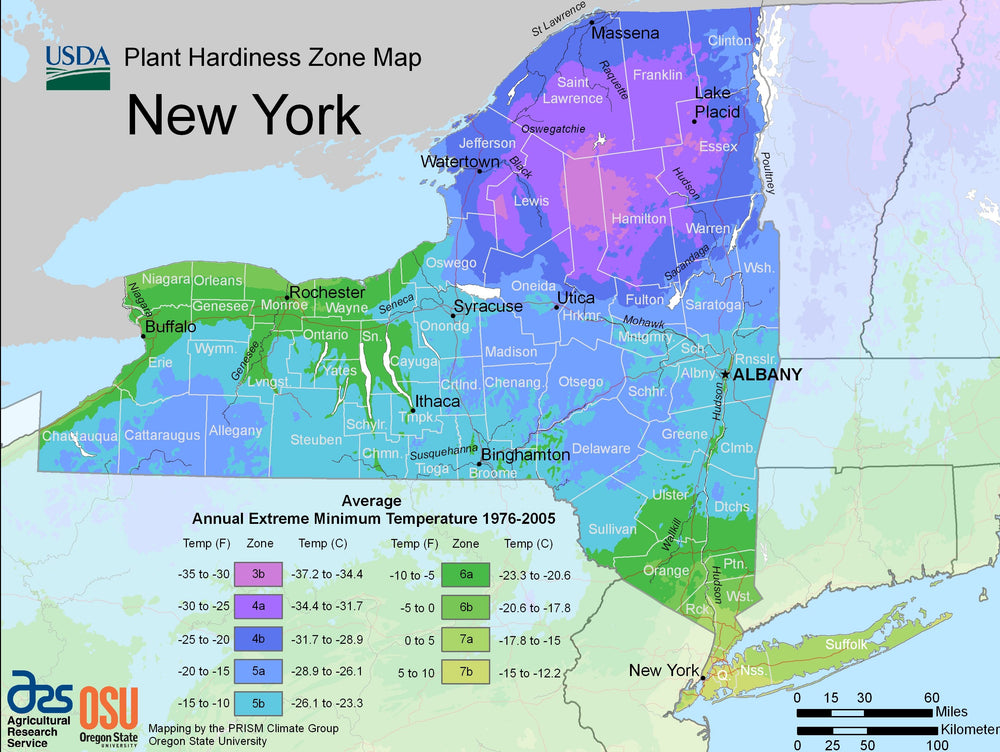Image from USDA
Characteristics of New York Planting Region
The climate of New York state is primarily humid continental, characterized by moderate to hot, humid summers and frigid winters with episodes of bitter cold and high winds. The winters also see abundant snowfall. Rochester and Buffalo are consistently listed as some of the snowiest cities in the USA.
New York State also experiences a variety of extreme weather conditions, including:
- Floods
- Droughts
- Heat Waves
- Coastal storms
- Heavy snowfall
- Ice storms
- Severe storms
- Wildfires
The length of the growing season varies depending on the region you’re located in. For example, the last frost date can be anywhere between April 15th and May 15th, while the first frost tends to happen from September 1st to October 15th.

Hunter, New York
Challenges of Growing in New York
1. Extreme Weather
The extreme weather conditions across the state pose many risks for gardeners. Droughts, storms, and floods can damage your plants and leave you empty-handed. It’s wise to use raised garden beds and protective coverings to avoid damaging your plants.
2. Heat Waves
New York regularly experiences severe heat waves in the summer months. This type of weather can quickly wilt or kill a number of your plants. Monitoring the temperature and alternating between indoor and outdoor growing may be necessary for your garden’s survival.
3. Heavy Snowfall
New York State is known for its abundant snowfall, with the average annual snowfall sitting around 70 inches. Unfortunately, this can dramatically limit your ability to extend your growing season into the winter months unless you make use of a protective covering or indoor growing.

Livingston Manor, New York
The Benefits of Using a Greenhouse in New York
There are several advantages of using a greenhouse in New York State. First, it will offer protection from extreme weather conditions and allow you to regulate temperatures, humidity and airflow during heat waves. Additionally, a greenhouse will help extend your growing season well into the cold winter months, providing opportunities to experiment with a wider variety of plants.
1. Extend your Growing Season
-
Without a Greenhouse:
Outdoor gardeners in New York can expect a brief growing season of 3-4 months on average. This short planting timeframe comes with several limitations on what types of plants will thrive. Many will need to be planted indoors and transplanted in outdoor gardens at a later date.
-
With a Greenhouse:
Greenhouse gardening will dramatically extend your growing season in New York. Gardeners can expect a planting season of 7-10 months depending on what zone you’re located in. The ability to double or even triple your growing timeframe makes a greenhouse a fantastic investment for this region.
Learn more about specific growing dates for your area and the best vegetables to plant in each part of New York.


Customer images of the Sungrow Greenhouse from East Aurora, New York
2. Grow a Wider Variety of Vegetables
-
Without a Greenhouse:
Shorter growing seasons and longer winters in New York mean many gardeners will need to opt for cool-hardy vegetables unless utilizing an element of indoor growing. Some of the crops that will thrive in this region include:
- Kale
- Spinach
- Lettuce
- Broccoli
- Beets
- Peas
- Radishes
- Turnips
-
With a Greenhouse:
Using a greenhouse will open the door to countless more vegetable options for New Yorkers. Both warm and cool-season vegetables will flourish throughout the extended growing season. The following are popular vegetable selections for greenhouse gardeners:
- Carrots
- Cucumbers
- Artichokes
- Asparagus
- Pumpkins
- Winter Squash
- Cantaloupe
- Eggplant
- Tomatoes
- Bell Peppers
- Lima Beans
- Basil
- Summer Squash
- Sweet Corn
- Zucchini
- Green Beans
- Garlic
- Watercress
- Leeks
- Celery
- Spanish Onion
- Jalapeños
- Potatoes

Lettuce
Why Planta Greenhouses?
- Wind resistant up to 65 mph (learn more about how our greenhouses hold up in high-altitude climates).
- Withstands a snow load of up to 98 psf (480kg/square meter).
- Made with a heavy-duty galvanized steel frame.
- Polycarbonate panels provide 100% protection against UV rays.
- The Sungrow greenhouse is bell-shaped - allows the wind, snow, and hail to slide off the sides.
- Extendable (Sungrow, Sigma and Farmer models can be extended beyond 100ft)
- Made in Europe and are exclusively imported
- Maintenance-free

